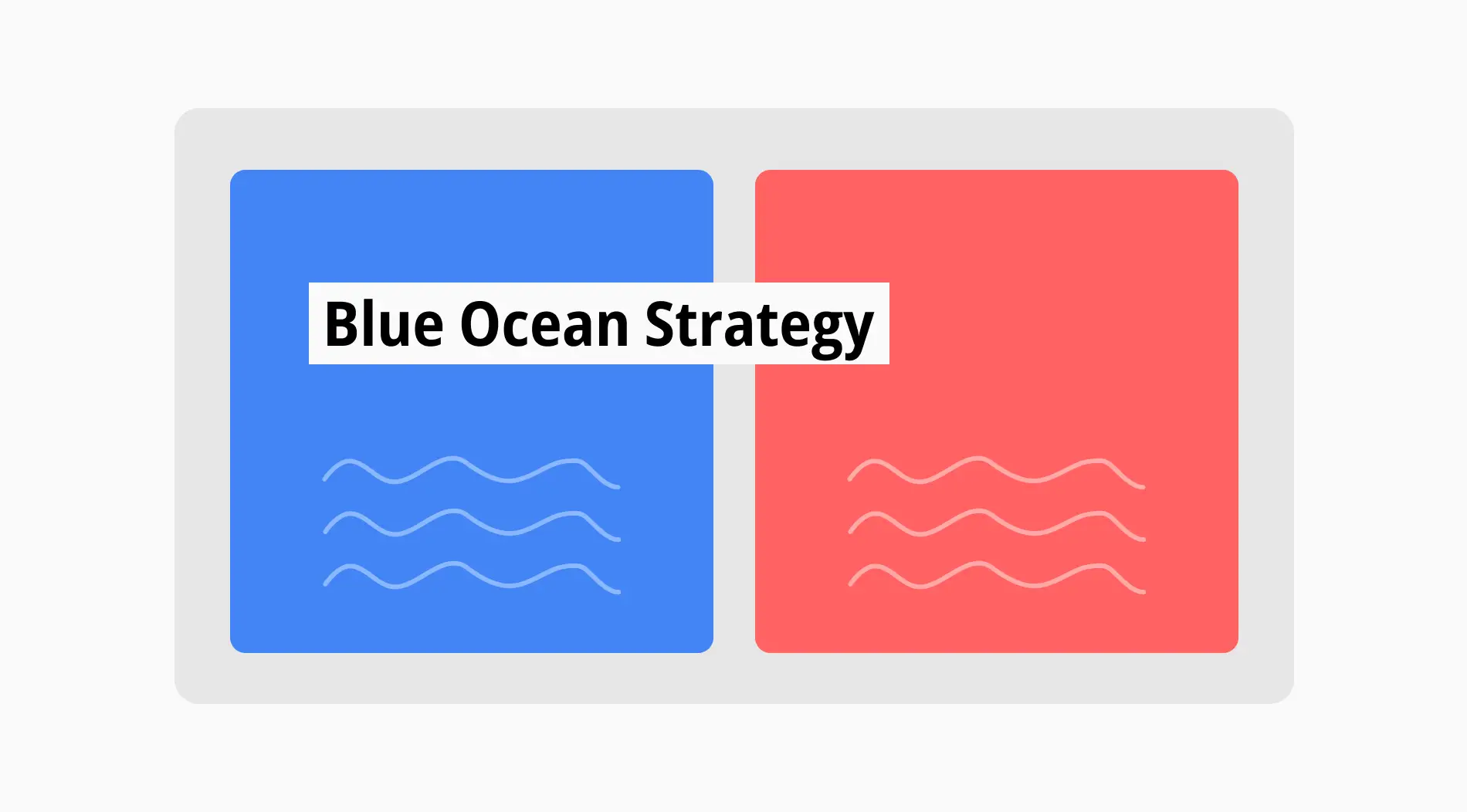You can use some essential tools as a way to escape fierce competition and explore other market spaces. By focusing on creating unique value, your company can discover new opportunities and drive growth. This approach also encourages innovation and shifts the focus from battling rivals to capturing new demands.
In this article, we will cover one of these tools, the Blue Ocean Strategy. It is a powerful tool for achieving business success by moving away from competitive markets. We will provide a step-by-step guide on how to conduct one and some real-life examples. We will also discuss some advantages/drawbacks, similar strategies, and some FAQs about the subject.
The Blue Ocean Strategy: Definition
Blue Ocean Strategy is a business framework to help your company create new market spaces, or blue oceans.
It focuses on new opportunities rather than competing in already crowded markets or red oceans. Chan Kim and Renée Mauborgne developed this strategy, focusing on innovation and value creation to break free from the intense competition.
The main principle of the Blue Ocean Strategy is to move away from the traditional competition-focused mindset. Instead of competing within an existing industry, your company can innovate, creating a blue ocean. This strategy involves analyzing market conditions and identifying areas where competition is minimal. With this strategy, your business can develop unique products or services that stand out.
The Blue Ocean Strategy: Core principles
Let’s get a deeper understanding of the blue ocean strategy. It outlines six core principles to help your business create and capture blue oceans. The blue ocean refers to uncontested market spaces. We will cover the core principles, which outline which issues you should consider before/while implementing the blue ocean strategy.
Here are these six core principles for your company:
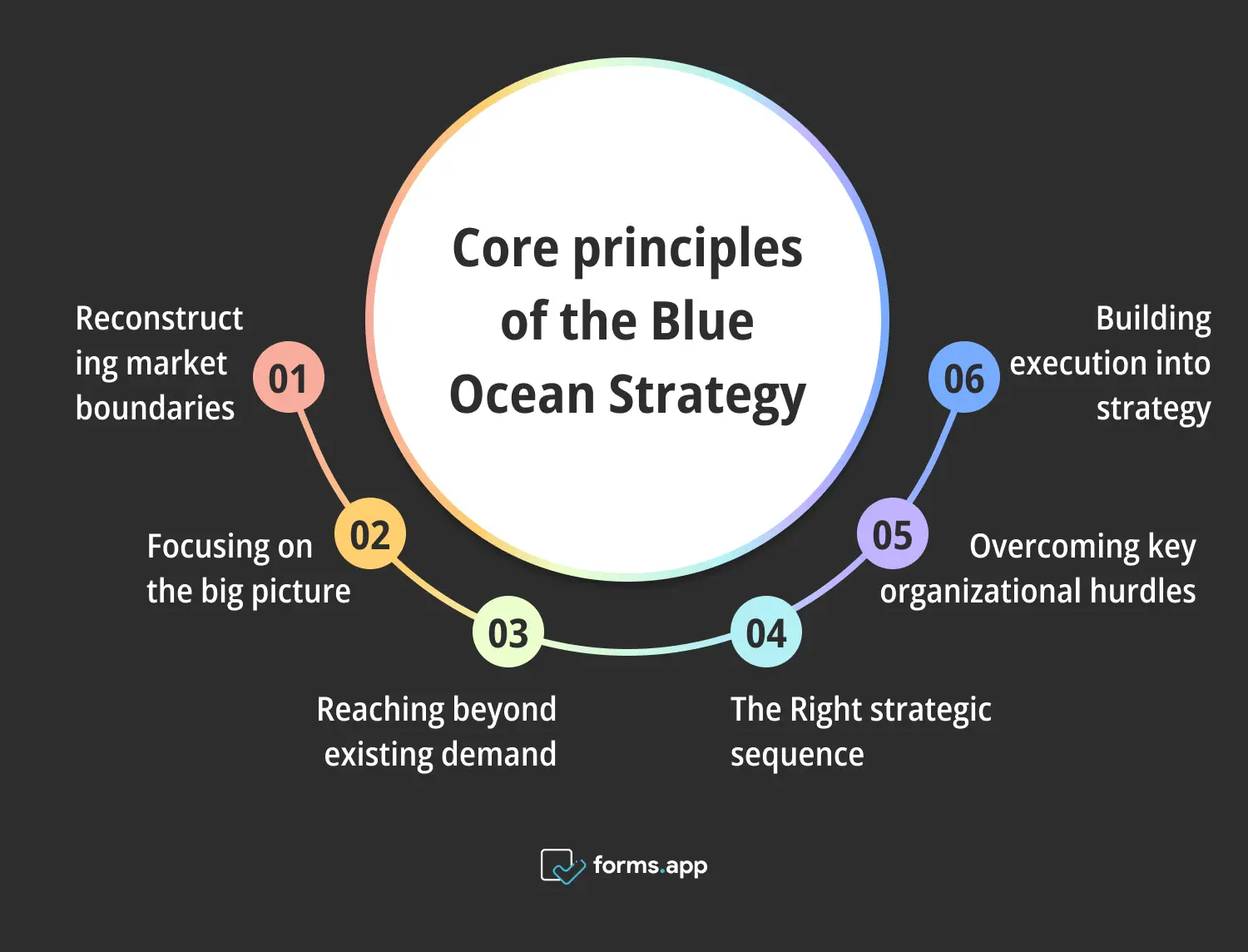
Core principles of the Blue Ocean Strategy
Principle 1: Reconstructing market boundaries
The blue ocean strategy involves reconstructing market boundaries. It means looking beyond the existing industry structure to identify new growth opportunities. Your business can achieve this by analyzing factors such as alternative industries. By redefining these boundaries, you can discover the unmet needs and create innovative offerings to capture new demand.
Principle 2: Focusing on the big picture
Focusing on the big picture means concentrating on the overall strategy. Do not just focus on the detailed metrics and numbers. This core principle encourages your business to develop a clear and compelling vision. This vision will guide your actions and decisions. When you keep the focus on the big picture, you can ensure that your efforts align with your long-term goals.
Principle 3: Reaching beyond existing demand
One of the other core principles of the Blue Ocean Strategy is reaching beyond the existing demands. This means looking for ways to attract non-customers and expand the market. This principle highlights understanding the reasons why potential customers are not currently buying and developing solutions. These solutions should address their needs and concerns. Your business can have new sources of demand.
Principle 4: The Right strategic sequence
This core principle includes assessing the buyer's utility, setting a strategic price, targeting the right cost, and adopting the right business model. It ensures that your every step aligns with your overall strategy. The right strategic sequence enables your value proposition to remain compelling and feasible. Your business can deliver value to the customers and drive growth.
Principle 5: Overcoming key organizational hurdles
Overcoming key organizational hurdles means addressing challenges within your company that may prevent successful implementation. It includes cognitive, political, motivational, and resource-based challenges. Your business should ensure that its strategy remains effective. This core principle emphasizes the importance of building a strong organizational foundation. This enables the successful execution of innovative strategies.
Principle 6: Building execution into strategy
Building execution into strategy means integrating your implementation into your strategic planning. It highlights the importance of ensuring that your strategy is actionable and your organization is ready to implement it effectively. This way, your business can avoid the common pitfalls of strategic initiatives that fail due to poor implementation. This approach ensures that your strategy remains well-conceived and leads to successful outcomes.
How to conduct the blue ocean strategy in your own business
Now that we have covered the core principles you should consider, let’s dive into which steps to follow. Here, we will cover step-by-step how to conduct the blue ocean strategy successfully in your business. Here are 6 steps to follow:
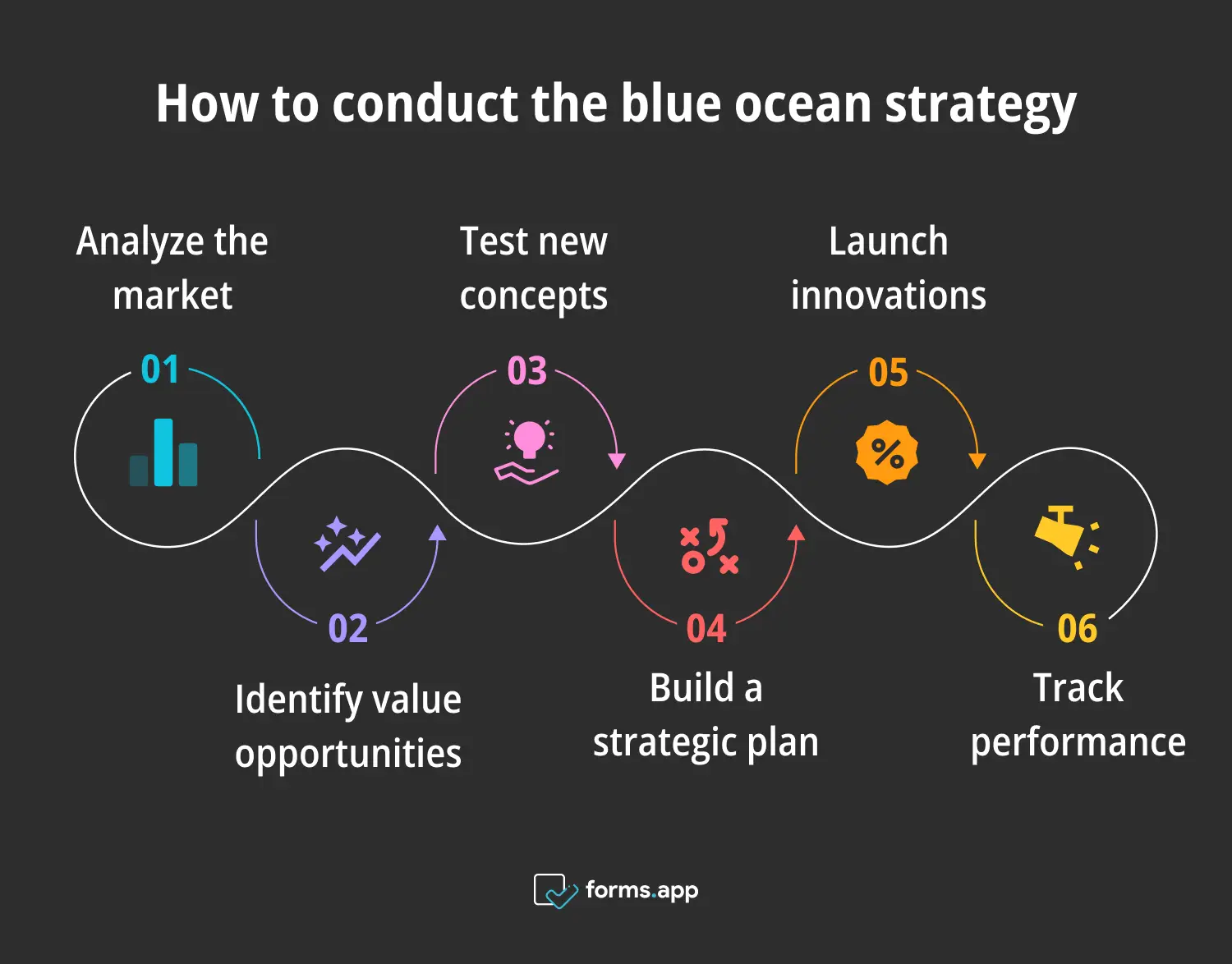
Steps for the Blue Ocean Strategy
1- Understand the current market landscape
The first step in the Blue Ocean Strategy is to understand your current market landscape. You should conduct comprehensive market research to gain insights into existing industry conditions, customer preferences, and competitive dynamics. You can use blue ocean strategy tools such as SWOT analysis, PEST analysis, and low-cost marketing strategies to assess the strengths and weaknesses in your market.
This step is crucial as it provides a clear picture of the competitive environment and helps you identify areas where your business can innovate and create new value. If you can thoroughly understand your current market landscape, you can identify gaps and unmet needs that your business can address via unique offerings.
2- Identify and map value innovation opportunities
The second step involves identifying and mapping value innovation opportunities. Value innovation is the cornerstone of the Blue Ocean Strategy. It focuses on creating new value for both your customers and your business. Start by analyzing customer feedback, industry trends, and technological advancements. You can uncover the areas where innovation can provide significant benefits.
Use tools like the Strategy Canvas to visualize and compare the current state of the industry and identify areas for innovation. Analyze the factors that allow your business to offer unique value. Map out these opportunities so that you can develop a clear strategy for creating products or services that will stand out in your market.
3- Develop and test new concepts
Once you have identified value innovation opportunities, the next step is developing and testing new concepts. It involves brainstorming and designing innovative products, services, or business models to address the gaps and unmet needs. You need to engage cross-functional teams to create diverse ideas and perspectives. Create prototypes or minimum viable products (MVPs) to test these concepts with a target audience.
Conduct pilot programs, gather feedback, and repeat this according to customer responses. Testing new concepts is crucial for you to validate the viability of your products/services and ensure that they meet the customer expectations. It also helps identify potential challenges and refine the offerings before the ultimate launch. This development and testing process ensures that your innovations remain well-received.
Step 4: Create a strategic blueprint
After developing and testing new concepts, create a strategic blueprint to outline how you will implement the Blue Ocean Strategy. This blueprint should include detailed plans for product development, marketing, distribution, and customer engagement. Define the unique value propositions of your innovations and how they will be communicated to your target audience. Establish clear goals, timelines, and metrics for measuring success.
The strategic blueprint should serve as a roadmap for guiding your actions and ensuring that all aspects of your strategy remain aligned. It also helps you allocate resources effectively and select your initiatives driving the most value properly. By doing this, you can execute your Blue Ocean Strategy and achieve your desired outcomes.
Step 5: Implement and Launch innovations
With the strategic blueprint in your hands, proceed to implement and launch your innovations. This step involves executing the plans outlined in your blueprint. It includes finalizing your product development, setting up distribution channels, and launching marketing campaigns. Ensure that your team is ready for the rollout. Communicate the unique value propositions clearly to your target audience through marketing and promotional items.
Monitor the launch closely to gather initial feedback and assess market response. This step is critical for bringing your innovations to market and gaining early traction. Successful implementation requires careful planning, coordination, and execution. This ensures that your offerings meet customer expectations and stand out in your industry.
Step 6: Monitor performance and Gather feedback
After launching your innovations, continuously monitor their performance and gather feedback from customers. Track key metrics such as sales, customer satisfaction, market share, and profits to evaluate your success. Use customer feedback to identify areas for improvement and make necessary adjustments. Remember, the Blue Ocean Strategy is a dynamic process.
Monitoring performance helps you understand how well the customers receive your innovations. It also provides insights into market dynamics and responses from your competition. You should regularly review and analyze your performance data. This allows you to refine your strategy and make informed decisions to enhance the effectiveness of your Blue Ocean initiatives.
Blue Ocean Strategy examples
We have covered the core principles and steps for successfully implementing the blue ocean strategy. The blue ocean strategy is all about sailing towards new oceans. These oceans are markets in the business context. Let’s look at how some of the well-known businesses of today used this strategy and achieved positive results:
Example 1: Tesla
Tesla is a very good example of the success that the Blue Ocean Strategy can bring. Before Tesla, the electric vehicle market was niche and lacked mainstream appeal. Tesla created a new market space (blue ocean) by combining advanced technology with high-performance electric cars. This became a rival of the traditional gasoline vehicles.
Their focus on innovation, design, and performance helped Tesla stand out from established automotive companies and created a new demand for electric vehicles. This approach not only revolutionized the automotive industry but also established Tesla as a leader in sustainable transportation.
Example 2: Apple
Apple’s introduction of the iPhone is also a prime example of the Blue Ocean Strategy. Before the iPhone, the smartphone industry was saturated with devices with physical keyboards and limited functionality. Apple created a new market space with the iPhone, which combined a touch-screen interface with internet capabilities and an app ecosystem.
This innovative approach not only set Apple apart from competitors but also created a new category of devices. It leads to significant growth and a dominant position in the market. Apple is still one of the most dominant smartphone companies due to its Blue Ocean Strategy. After Apple, we can also see many other rivals sailing into this ocean.
Example 3: Nintendo Wii
Before the Wii, the gaming industry was all about advanced graphics and powerful hardware. Nintendo shifted its focus(blue ocean shift) to a broader audience, including families, casual gamers, and elderly players. It created an intuitive motion-sensing controller and offered games that appealed to non-traditional gamers.
This appealed to non-traditional gamers. By doing this, Nintendo tapped into a previously untouched market. The Wii’s unique value proposition allowed Nintendo to avoid direct competition with Sony and Microsoft. It also captured new demand and achieved massive success without engaging in the intense hardware race dominating the industry.
Red ocean vs. Blue ocean strategy
Red Ocean and Blue Ocean strategies represent two distinct approaches to market competition and growth. Red Ocean Strategy focuses on competing within existing market boundaries. On the contrary, the Blue Ocean Strategy seeks to create new market spaces and demand. Here, let’s take a look at the six key comparisons of their key differences:
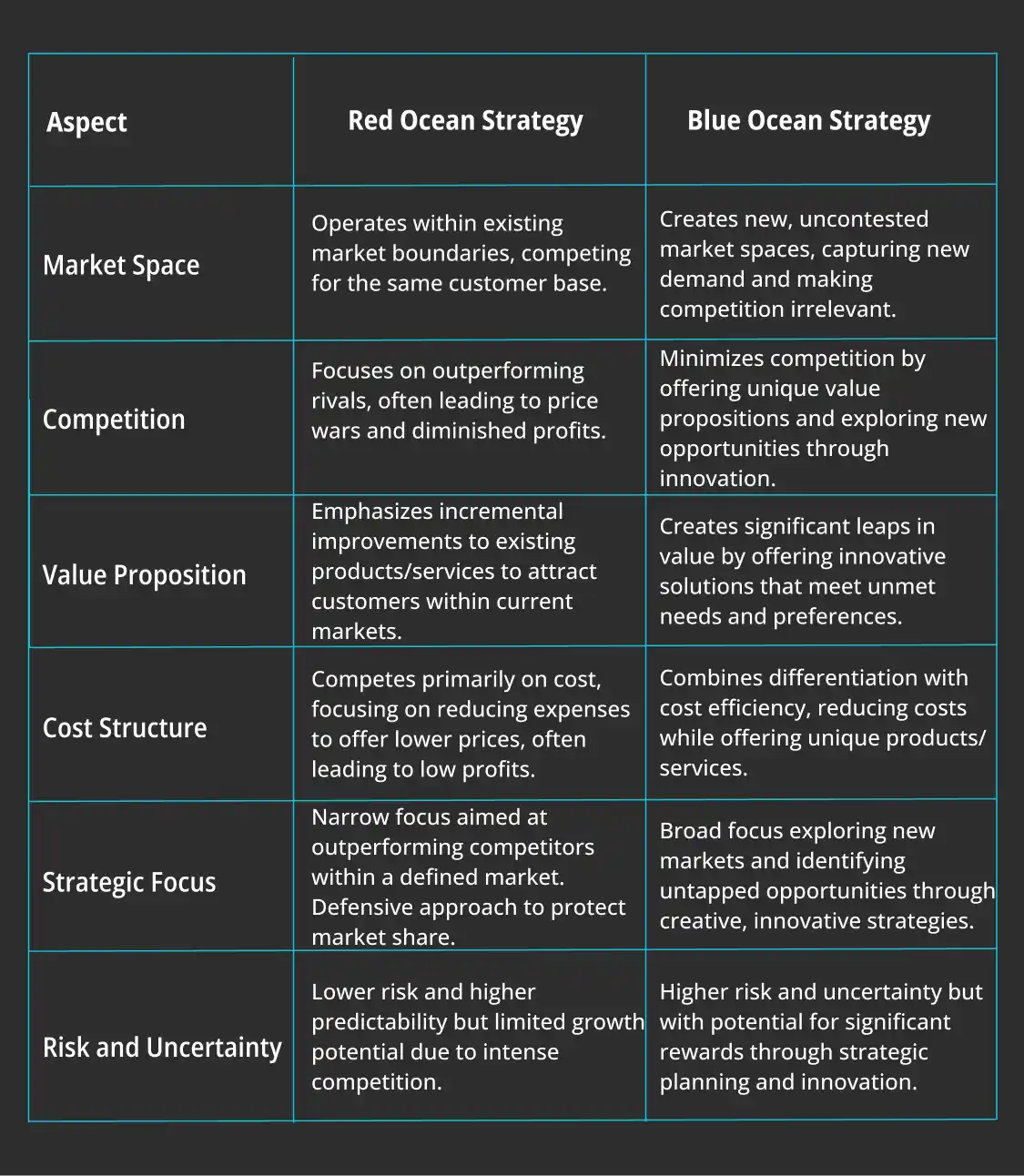
Blue Ocean Strategy vs. Red Ocean Strategy
Market space
Red Ocean Strategy operates within existing market boundaries, competing for the same customer base. Companies focus on outperforming rivals to gain a larger market share. However, the Blue Ocean Strategy seeks to create new, uncontested market spaces. It aims to capture new demand and make the competition irrelevant by offering unique value propositions that attract different customers.
Competition
In the Red Ocean Strategy, the competition often leads to price wars with diminished profits. Businesses strive to bear their competitors by offering better products or services at lower prices. On the other hand, the Blue Ocean Strategy minimizes the competition and creases unique offerings. Here, the companies can avoid direct competition and focus on new opportunities through value innovation.
Value proposition
Red Ocean Strategy emphasizes incremental improvements to existing products and services to attract customers. The goal is to provide better value within the constraints of the existing market. Blue Ocean Strategy characteristics differ. Here, it aims to create significant leaps in value for both the company and the customers. It offers innovative solutions that meet previously unmet needs and preferences in the market created.
Cost structure
In the Red Ocean Strategy, businesses often compete on cost. This leads to a focus on reducing expenses to offer low prices. This can result in a race to the bottom and low profits. Blue Ocean Strategy combines differentiation with cost efficiency. By creating new value propositions, companies can reduce costs while offering unique products or services that command higher prices.
Strategic focus
Red Ocean Strategy typically has a narrower strategic focus. It aims to outperform competitors within a defined market space. It invoşves a more defensive approach, protecting market share and profits. Blue Ocean Strategy, in contrast, encourages a broader strategic focus. It involves exploring new markets and identifying untapped opportunities. It encourages thinking creatively about how to serve customers in innovative ways.
Risk and uncertainty
Red Ocean Strategy generally entails lower risk and higher predictability as it operates within established markets. However, the intense competition can limit growth potential and profits. Blue Ocean strategy invoices higher risk and uncertainty due to the exploration of unmarked territories. While the potential rewards are more significant, it requires careful planning and adaptation to succeed.
Advantages & disadvantages of the Blue Ocean Strategy
The Blue Ocean strategy requires thorough planning and careful implementation. We touched on the advantages briefly when we were exploring the steps to follow and examples. However, you should keep in mind that this strategy may also come with drawbacks, like many other models. Here, let’s take a look at the advantages and disadvantages in a more detailed manner:
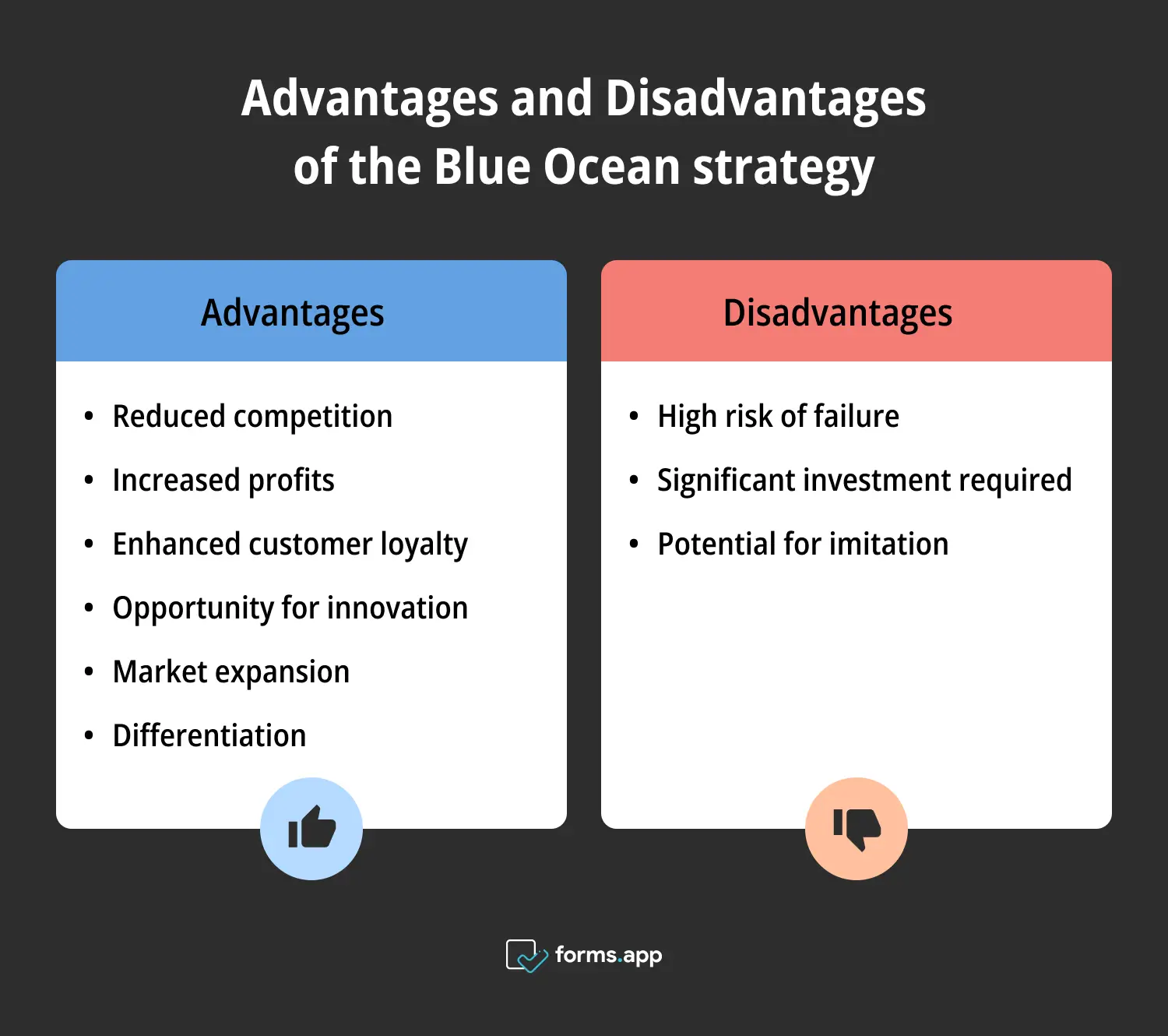
Pros and cons of the Blue Ocean Strategy
Advantages
➕Reduced competition: One key advantage of the Blue Ocean Strategy is the reduction of competition. By creating new market spaces and offering unique value propositions, businesses can avoid direct competition with existing industry players.
➕Increased profits: Implementing the Blue Ocean Strategy often leads to profitable growth. By offering unique products or services that address unmet needs, businesses can command higher prices and achieve better profit margins.
➕Enhanced customer loyalty: The Blue Ocean Strategy can enhance customer loyalty by providing unique and valuable offerings that meet unmet needs. When customers perceive that a business offers something distinct and beneficial, they are more likely to become loyal to the brand.
➕Opportunity for innovation: Blue Ocean Strategy encourages innovation by focusing on creating new value rather than competing in existing markets. This approach stimulates creative thinking and exploration of new ideas, leading to the development of unique products or services.
➕Market expansion: Implementing the Blue Ocean Strategy can lead to market expansion by identifying and entering new market spaces. By creating new demand and addressing unmet needs, businesses can reach previously untapped customer segments and explore new geographical regions.
➕Differentiation: Differentiation is a significant advantage of the Blue Ocean Strategy. By focusing on creating unique value propositions, businesses can distinguish themselves from competitors and establish a distinct market position. Differentiation helps companies attract customers seeking innovative solutions.
Disadvantages
➖High risk of failure: One drawback of the Blue Ocean Strategy is the high risk of failure associated with creating new market spaces. Developing innovative products or services that do not resonate with customers can lead to significant losses. The uncertainty of entering uncharted territories means that businesses must invest in research and development without guaranteed success.
➖Significant investment required: Implementing the Blue Ocean Strategy often requires a significant investment in research, development, and marketing. Creating new value propositions and entering new market spaces can be costly and resource-intensive. Businesses must allocate substantial funds to innovation, market research, and promotional efforts to successfully launch and sustain their new offerings.
➖Potential for imitation: Another drawback of the Blue Ocean Strategy is the potential for imitation by competitors. Once a business successfully creates a new market space or innovative offering, other companies may quickly recognize the value and seek to replicate it. This can lead to increased competition and erode the initial competitive advantage.
Frequently Asked Questions about the Blue Ocean Strategy
Last but not least, let’s answer some of the most frequently asked questions about the blue ocean strategy. These answers will help you get a clearer understanding of the subject. They will also give you an idea about how to successfully implement the blue ocean strategy in your business:
The main goal of the Blue Ocean Strategy is to create new market spaces and demand, making competition irrelevant. By focusing on innovation and value creation rather than competing in existing markets, businesses can find unique growth opportunities. This approach allows companies to differentiate themselves and capture new customer segments, leading to increased profitability and a strong competitive advantage.
Blue Ocean Strategy focuses on creating new, uncontested market spaces to avoid competition and attract new customers through innovation. In contrast, the Red Ocean Strategy competes within existing market boundaries, where businesses vie for market share, often leading to intense rivalry and price wars. Blue Ocean seeks differentiation and new demand, while Red Ocean emphasizes competing in saturated markets.
Implementing the Blue Ocean Strategy offers several benefits: it allows companies to create and capture new market demand, reduce competition, and achieve higher profitability by innovating beyond existing market constraints. By focusing on value innovation, businesses can differentiate themselves, attract a broader audience, and unlock new growth opportunities, leading to a more sustainable competitive advantage.
Key points to take away
In conclusion, the Blue Ocean Strategy provides a valuable framework for businesses looking to escape intense competition and explore new market opportunities. By focusing on innovation and creating unique value propositions, companies can differentiate themselves and capture untapped demand. Implementing this strategy involves understanding market boundaries, identifying unmet needs, and developing innovative solutions.
In this article, we have covered the definition of blue ocean strategy and provided examples. We have provided a step-by-step guide. We have also compared it with the red ocean strategy to understand the differences. Finally, we explored the advantages, drawbacks, and frequently asked questions. Use the blue ocean strategy in your business and create your own market today!
Fatih is a content writer at forms.app and a translator specializing in many text domains, including medical, legal, and technical. He loves studying foreign languages. Fatih especially likes to create content about program management, organizational models, and planning tools.
- The Blue Ocean Strategy: Definition
- The Blue Ocean Strategy: Core principles
- How to conduct the blue ocean strategy in your own business
- Blue Ocean Strategy examples
- Red ocean vs. Blue ocean strategy
- Advantages & disadvantages of the Blue Ocean Strategy
- Frequently Asked Questions about the Blue Ocean Strategy
- Key points to take away
